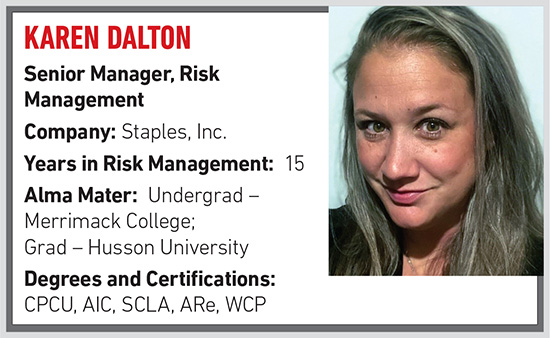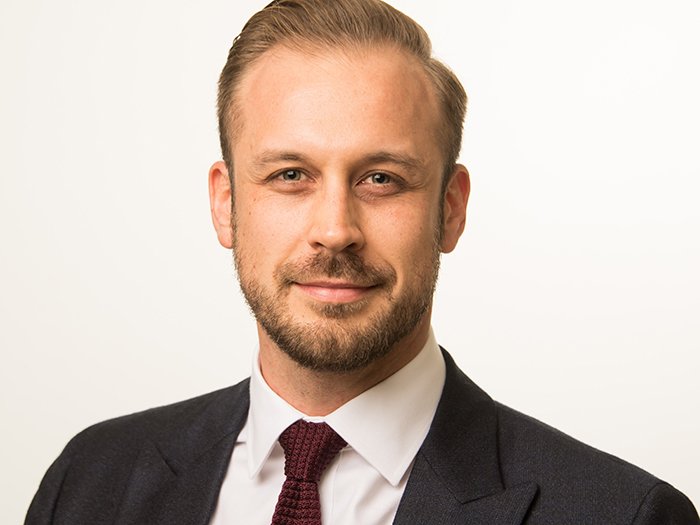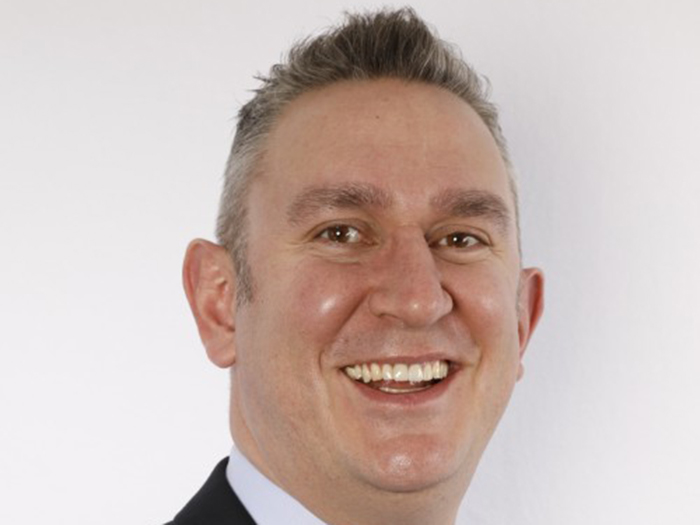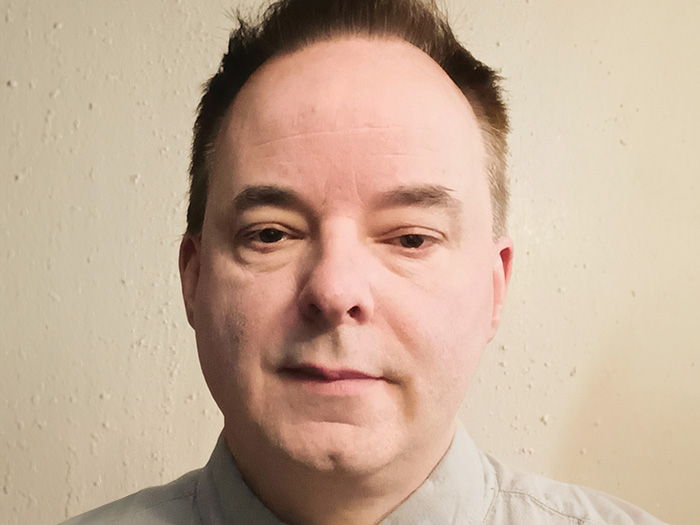Staples’ Karen Dalton Shares How She Went from Working in Insurance to Launching a New Claims Management Program in a Month

R&I: What was your first job?
My mother owned a dry cleaners, so I grew up there and that was my official first paid job. But my first job in the insurance industry was as a medical-only workers’ comp adjuster.
R&I: How did you come to your current position?
LinkedIn told me it would be a good fit. I wasn’t actively looking, but when I left my prior director position with a carrier in early 2018, I delved into the world of reinsurance a little bit to expand my breadth of knowledge and skillset in preparation for an eventual move into the employer side, into risk management.
I had the degree, I just needed to close the loop on what I thought would be helpful experience to have, so when LinkedIn told me I was a good fit for a company like Staples, I jumped at that chance. I’m super grateful to have a great boss who took a chance on someone who didn’t have experience on the employer side of the house when I took on this role.
R&I: What’s been the biggest change in risk management and the insurance industry since you’ve been in it?
That’s a tough one. There’s been a number of big changes even just in the past handful of years. I mean, obviously COVID has turned everything on its head, but just the questions that are required upon renewal now have drastically increased, because we have carriers more concerned about liquidity and assets post-pandemic. We have cyber and ransomware attacks rising dramatically, so in those cases, we’re seeing carriers either refusing to write coverages or reducing limits offered and increasing premium provisions.
From an employer perspective, in my experience, it seems as though more employers are coming around to the need for proactive risk management and not just reactive risk mitigation.
R&I: What’s the biggest challenge you’ve faced in your career?
Honestly, it’s being held back; it’s having my hands tied. I’m a go-getter. If I see an issue, I want to tackle it, resolve it and move on. I’ve worked in some places where my hands were tied, not due to financial reasons but just due to that administrative bureaucracy, which is really frustrating, because I’ve always had a great team of people by my side.
They’ve helped me tackle a lot of these systemic issues that we’ve run into. And it’s just rare in my experience to get the buy-in needed to make real change from the top down.
I’m really thankful that in my current role I’m being given the opportunity to make those changes needed to ensure our entire insurance and risk programs are running smoothly and supporting our associates.
We have a knowledgeable management team that understands our exposure, so in the end, we have a positive financial impact. I’ve worked in organizations where it felt like everybody from the janitor to the CEO needed to approve everything and that was really challenging for me.
R&I: Who has been your mentor(s) and why?
I’ve had various mentors over the years. I’m really lucky. Most of my superiors have recognized that I have the drive to succeed, and they’ve really done everything in their power to help me reach my goals.
In cases where I’ve had an opportunity to select a mentor, I’ve always leaned towards someone who was either in a role that I wanted or had a skillset that I sought to obtain. I learned and absorbed everything I could from them and then just put my own twist on it to make it work for me based on my current situation.
R&I: What is the risk management community doing right?
In the past few years, a lot of risk managers have moved away from that checkbox mentality. That was often the majority of the risk management process; it was always very compliance heavy. We thought just making sure we ticked all the boxes would suffice in terms of saying we did everything we could to avoid and mitigate our risks.
Now, don’t get me wrong, I was the director of claim compliance for a carrier, so I’m all about making sure we meet our requirements and have our boxes checked, but I feel like there’s a much more important part of the risk management process that really creates a holistic drive to avoid and mitigate risks.
And that’s more so about conversing with the right people and getting their buy-in as to the process, with preventable internal risks being discussed alongside loss prevention and strategic risks with those at the C-suite level to determine how much risk the organization is really willing to take, and then external risk being discussed with the subject matter experts in the field.
As we start to do all three of those, they have to be done as a comprehensive risk management strategy.
Historically, many of the functions were siloed, and the lack of cohesion among all those different facets of the risk management process is just a recipe for disaster. So in speaking to colleagues in the industry, I believe it’s become evident there’s a more collaborative approach being taken to the process right now, which is really a win-win.
R&I: What could the risk management community be doing a better job of?
Pushing back on this idea that their company equals their industry. It’s really rare for a business to have a true apples to apples competitor, same revenues, exposures, footprint etc.
We’re all compared to others in our general industry, but rarely is that ever an accurate representation of a single company’s performance. And then when renewal time comes around, carriers utilize that industry benchmark to justify their rates. When your company is performing exceptionally well year after year but the industry is not, to be forced to absorb those rate increases is frustrating.
If risk managers consistently push back harder with objective evidence as to why they should not be subject to those increased rates, carriers may finally be forced to retire this archaic method of rate making and instead be forced to really review each insured, at least of significant premium size, on its own merits.
R&I: What does it take to implement an entirely new claims management program in less than a month, as you did with Essendant?
Essendant is a sister company to Staples, and risk management is one of the shared services. We fall under the same private equity umbrella. At the end of the day, it takes dedication and pushing through the hurdles that come with trying to do something that should take months in a very short period of time.
I’m not going to say it was perfect and it was executed flawlessly, but it has already proven to have had a positive effect on the business. We have to wait and see a little bit what the results will be, since we’re only going into month eight in terms of the financials, but so far we’re seeing really positive results.
Collaboration is a huge piece of that. The TPA partner, myself, colleagues within Staples and key partners within Essendant all came together to think about how we could get over the hurdles of the initial implementation in such a short timeframe, and from that point forward have continued to deal with hiccups as they come up as a group.
Do I recommend trying to fast track implementation of entirely new vendors and processes in a matter of weeks? No. It’s not the ideal way to go, but at the end of the day, it’s better for our business, and long-term there is projected to be considerable financial savings.
R&I: What’s your favorite book or movie?
My favorite book is The Lovely Bones by Alice Sebold, and my favorite movie — apparently I just like things from the early 2000s — is Remember the Titans.
R&I: What is your favorite drink?
That depends on the time of day. During the day I am primarily sitting here with a strawberry kiwi water, but by night, it’s a concoction that my husband, who used to be a bartender, created for me when I said I wanted something tropical tasting. All I know is that it has some pineapple juice, spice and coconut rum.
R&I: What have you accomplished that you are proudest of?
Making it this far in my career at a relatively young age while raising a family. I’ve always worked full time outside of my home — I have four kids including a toddler. I coach youth soccer. I’m the president of the board of our soccer league. I finished my master’s and attained my CPCU, with some other designations sprinkled in there, and anybody who’s done their CPCU knows just that in and of itself is incredibly challenging.
But I did those couple of things all in about three years. It was a ton of hard work, but I’m really proud to have made it to where I am today, to have the level of experience and the breadth of knowledge that I’ve been able to obtain in the span of the past 15 years.
R&I: What is the riskiest activity you’ve ever engaged in?
Well I’m in risk management, so I don’t really do a ton of risky things usually, but a handful of years ago, I was in Park City, Utah at the old Olympic Park, and they have a 160-foot-plus off-the-ground zip line that I was convinced to go down. It was definitely out of my comfort zone. &










